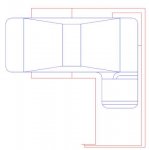I need some advice on pipe sizing. I have read some posts on here about pipe sizing and head, but still can't quite understand it. My pool will be 29250 gallons. I have a Hayward EcoStar variable speed pump with 2 skimmers, 6 returns, and no main drains.
My pump will be located about 120 feet away from the furthest skimmer. I was planning on running separate 3" suction pipes from each skimmer back to the pump and then separate 2" pipe for all 6 returns. I will have Jandy valves on all lines to control flow.
Are my pipe sizes ok? Most threads say to go with bigger suction pipe but others say it is overkill. The distance from the pump to the skimmers concerns me and I think bigger pipe will help.
After reading Hydraulics 101 thread, there was a table called Equivalent Pipe/Fitting Size. Then it stated "On the return side of the pump, multiple lines can help reduce head loss as well but the number of return lines should never exceed the number of suction or pump cavitation could become an issue."
Since I have (6) 2" return lines, that equals 4.81" according to the table. There isn't any values for 3" pipe, so I can't find what (2) 3" suction pipes are equivalent to and then compare it to the return.
My pump will be located about 120 feet away from the furthest skimmer. I was planning on running separate 3" suction pipes from each skimmer back to the pump and then separate 2" pipe for all 6 returns. I will have Jandy valves on all lines to control flow.
Are my pipe sizes ok? Most threads say to go with bigger suction pipe but others say it is overkill. The distance from the pump to the skimmers concerns me and I think bigger pipe will help.
After reading Hydraulics 101 thread, there was a table called Equivalent Pipe/Fitting Size. Then it stated "On the return side of the pump, multiple lines can help reduce head loss as well but the number of return lines should never exceed the number of suction or pump cavitation could become an issue."
Since I have (6) 2" return lines, that equals 4.81" according to the table. There isn't any values for 3" pipe, so I can't find what (2) 3" suction pipes are equivalent to and then compare it to the return.


